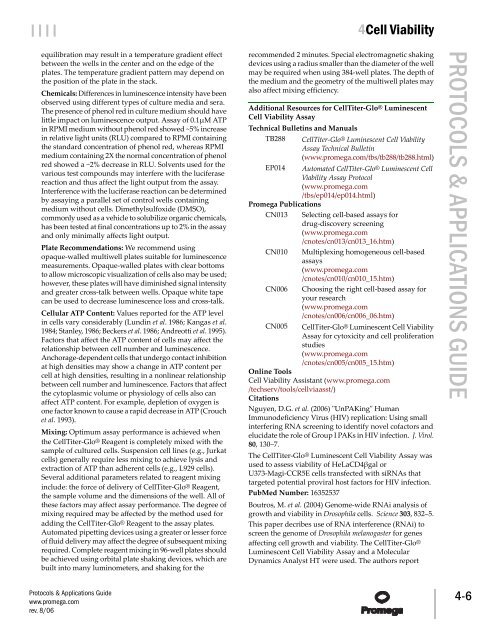Protocols and Applications Guide (US Letter Size) - Promega
Protocols and Applications Guide (US Letter Size) - Promega
Protocols and Applications Guide (US Letter Size) - Promega
Create successful ePaper yourself
Turn your PDF publications into a flip-book with our unique Google optimized e-Paper software.
|||| 4Cell Viability<br />
equilibration may result in a temperature gradient effect<br />
between the wells in the center <strong>and</strong> on the edge of the<br />
plates. The temperature gradient pattern may depend on<br />
the position of the plate in the stack.<br />
Chemicals: Differences in luminescence intensity have been<br />
observed using different types of culture media <strong>and</strong> sera.<br />
The presence of phenol red in culture medium should have<br />
little impact on luminescence output. Assay of 0.1µM ATP<br />
in RPMI medium without phenol red showed ~5% increase<br />
in relative light units (RLU) compared to RPMI containing<br />
the st<strong>and</strong>ard concentration of phenol red, whereas RPMI<br />
medium containing 2X the normal concentration of phenol<br />
red showed a ~2% decrease in RLU. Solvents used for the<br />
various test compounds may interfere with the luciferase<br />
reaction <strong>and</strong> thus affect the light output from the assay.<br />
Interference with the luciferase reaction can be determined<br />
by assaying a parallel set of control wells containing<br />
medium without cells. Dimethylsulfoxide (DMSO),<br />
commonly used as a vehicle to solubilize organic chemicals,<br />
has been tested at final concentrations up to 2% in the assay<br />
<strong>and</strong> only minimally affects light output.<br />
Plate Recommendations: We recommend using<br />
opaque-walled multiwell plates suitable for luminescence<br />
measurements. Opaque-walled plates with clear bottoms<br />
to allow microscopic visualization of cells also may be used;<br />
however, these plates will have diminished signal intensity<br />
<strong>and</strong> greater cross-talk between wells. Opaque white tape<br />
can be used to decrease luminescence loss <strong>and</strong> cross-talk.<br />
Cellular ATP Content: Values reported for the ATP level<br />
in cells vary considerably (Lundin et al. 1986; Kangas et al.<br />
1984; Stanley, 1986; Beckers et al. 1986; Andreotti et al. 1995).<br />
Factors that affect the ATP content of cells may affect the<br />
relationship between cell number <strong>and</strong> luminescence.<br />
Anchorage-dependent cells that undergo contact inhibition<br />
at high densities may show a change in ATP content per<br />
cell at high densities, resulting in a nonlinear relationship<br />
between cell number <strong>and</strong> luminescence. Factors that affect<br />
the cytoplasmic volume or physiology of cells also can<br />
affect ATP content. For example, depletion of oxygen is<br />
one factor known to cause a rapid decrease in ATP (Crouch<br />
et al. 1993).<br />
Mixing: Optimum assay performance is achieved when<br />
the CellTiter-Glo® Reagent is completely mixed with the<br />
sample of cultured cells. Suspension cell lines (e.g., Jurkat<br />
cells) generally require less mixing to achieve lysis <strong>and</strong><br />
extraction of ATP than adherent cells (e.g., L929 cells).<br />
Several additional parameters related to reagent mixing<br />
include: the force of delivery of CellTiter-Glo® Reagent,<br />
the sample volume <strong>and</strong> the dimensions of the well. All of<br />
these factors may affect assay performance. The degree of<br />
mixing required may be affected by the method used for<br />
adding the CellTiter-Glo® Reagent to the assay plates.<br />
Automated pipetting devices using a greater or lesser force<br />
of fluid delivery may affect the degree of subsequent mixing<br />
required. Complete reagent mixing in 96-well plates should<br />
be achieved using orbital plate shaking devices, which are<br />
built into many luminometers, <strong>and</strong> shaking for the<br />
<strong>Protocols</strong> & <strong>Applications</strong> <strong>Guide</strong><br />
www.promega.com<br />
rev. 8/06<br />
recommended 2 minutes. Special electromagnetic shaking<br />
devices using a radius smaller than the diameter of the well<br />
may be required when using 384-well plates. The depth of<br />
the medium <strong>and</strong> the geometry of the multiwell plates may<br />
also affect mixing efficiency.<br />
Additional Resources for CellTiter-Glo® Luminescent<br />
Cell Viability Assay<br />
Technical Bulletins <strong>and</strong> Manuals<br />
TB288 CellTiter-Glo® Luminescent Cell Viability<br />
Assay Technical Bulletin<br />
(www.promega.com/tbs/tb288/tb288.html)<br />
EP014 Automated CellTiter-Glo® Luminescent Cell<br />
Viability Assay Protocol<br />
(www.promega.com<br />
/tbs/ep014/ep014.html)<br />
<strong>Promega</strong> Publications<br />
CN013 Selecting cell-based assays for<br />
drug-discovery screening<br />
(www.promega.com<br />
/cnotes/cn013/cn013_16.htm)<br />
CN010 Multiplexing homogeneous cell-based<br />
assays<br />
(www.promega.com<br />
/cnotes/cn010/cn010_15.htm)<br />
CN006 Choosing the right cell-based assay for<br />
your research<br />
(www.promega.com<br />
/cnotes/cn006/cn006_06.htm)<br />
CN005 CellTiter-Glo® Luminescent Cell Viability<br />
Assay for cytoxicity <strong>and</strong> cell proliferation<br />
studies<br />
(www.promega.com<br />
/cnotes/cn005/cn005_15.htm)<br />
Online Tools<br />
Cell Viability Assistant (www.promega.com<br />
/techserv/tools/cellviaasst/)<br />
Citations<br />
Nguyen, D.G. et al. (2006) "UnPAKing" Human<br />
Immunodeficiency Virus (HIV) replication: Using small<br />
interfering RNA screening to identify novel cofactors <strong>and</strong><br />
elucidate the role of Group I PAKs in HIV infection. J. Virol.<br />
80, 130–7.<br />
The CellTiter-Glo® Luminescent Cell Viability Assay was<br />
used to assess viability of HeLaCD4βgal or<br />
U373-Magi-CCR5E cells transfected with siRNAs that<br />
targeted potential proviral host factors for HIV infection.<br />
PubMed Number: 16352537<br />
Boutros, M. et al. (2004) Genome-wide RNAi analysis of<br />
growth <strong>and</strong> viability in Drosophila cells. Science 303, 832–5.<br />
This paper decribes use of RNA interference (RNAi) to<br />
screen the genome of Drosophila melanogaster for genes<br />
affecting cell growth <strong>and</strong> viability. The CellTiter-Glo®<br />
Luminescent Cell Viability Assay <strong>and</strong> a Molecular<br />
Dynamics Analyst HT were used. The authors report<br />
PROTOCOLS & APPLICATIONS GUIDE 4-6
















